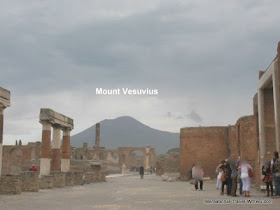 |
| Outside the ruins of Pompei |
The entrance to Pompei, the ancient city near Naples, Italy, that was partially buried by a volcanic eruption, is rather festive for such a somber location. There is a fine hotel and restaurant and a well-stocked gift shop with souvenirs and replica statues. Outside is a citrus stand that has not only fresh fruit but liqueurs that are citrus based. Nearby many other souvenir stalls line the streets close to tour bus loading zones.
Pompei (European spelling has one i) evokes visions of hot, molten lava spewing down upon an unprepared city without warning. It’s this mental image of such an epic tale that attracts hordes of tourists each year, including us. We opted to tour the streets where it all happened and imagine what life had been like prior to this horrific event. A visible hint to the weather conditions that the people of ancient Pompei dealt with was stepping stones embedded in the roads to enable crossing the streets during heavy rains. The streets were well planned and were mapped in ancient times. It is with these old records that the new nameplates are placed on the streets. They also provide the physical layout for those unearthing the buried city.
 |
| Ancient streets of Pompei are historically preserved. |
 |
| An eruption from Mount Vesuvious destroyed Pompei. |
There are also huge public areas such as the Pompei Forum with a marble entry door still standing, a testament to the longevity of Roman structures, that led to their marketplace. This is partially seen in the right hand side of the photo. Fountains, brothels, villas and simple homes have been unearthed…shining a spotlight on the lifestyles in ancient Pompei. Excavations continue, and each year more amazing discoveries surface while the ever powerful Mt. Vesuvius still looms menacingly over the ruins.
Photos courtesy of Carolynne Woods
Photos courtesy of Carolynne Woods
No comments:
Post a Comment